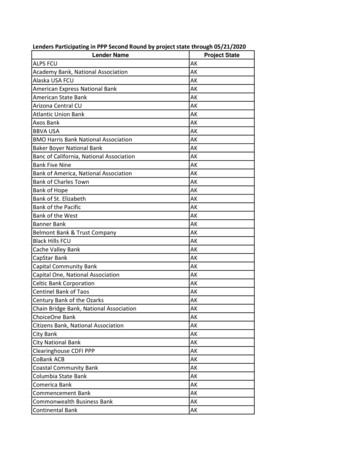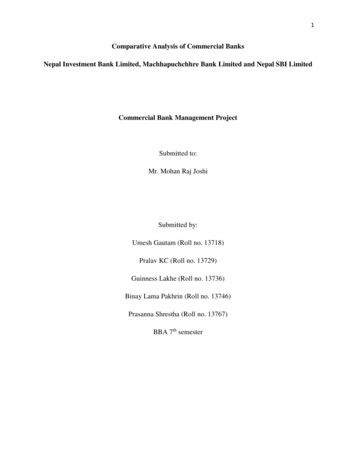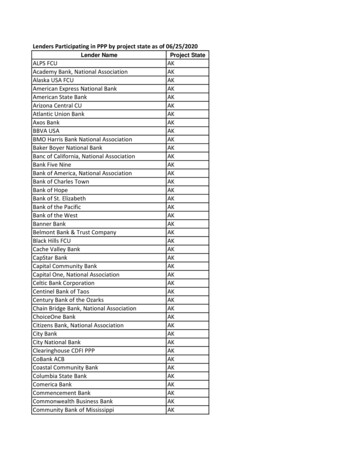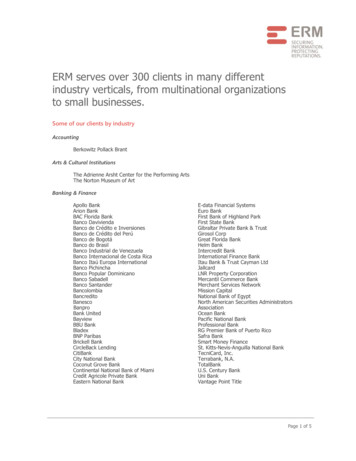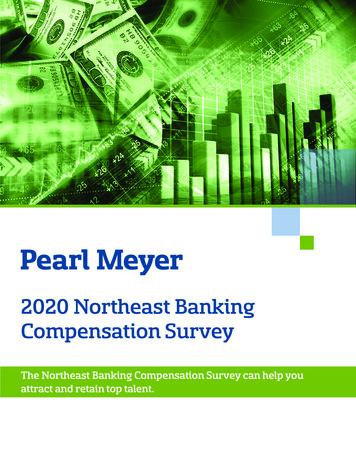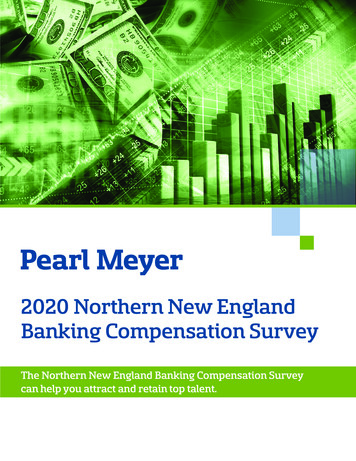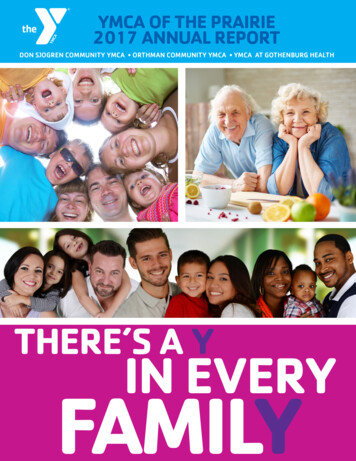
Transcription
BMO Wealth InstituteReportUS Edition DECEMBER 2015The Bank of Mom and Dad– a source of comfort for everyoneThe BMO Wealth Institute provides insights and strategiesaround wealth planning and financial decisions to betterprepare you for a confident financial future.
BMO Wealth InstituteThe Bank of Mom and Dad – a source of comfort for everyoneUS Edition DECEMBER 20152The perception of wealth influences how families use their financial resources to achieve personaland family goals. The Bank of Mom and Dad is seen as an important factor in helping meet thesegoals. These days, many parents feel they are on track to being financially comfortable, but worrythat their children are not going to attain the same level of comfort on their own resources.When asked what it takes to be considered wealthy, many families’ self-portraits have changeddramatically over the last few years. Rather than just thinking about accumulated assets,families are also focusing on their lifestyles as an indicator of family wealth.1 The emergenceof the concept of the bucket list in popular culture and the sharing of these experiencesthrough social media are examples of this change in focus.Most families relate to the idea of being part of the middle class, and do not considerthemselves wealthy. This view is supported by studies that show that as earnings increase,the amount of accumulated wealth required for families to consider themselves wealthy risesproportionately.2 This tendency to either understate or overstate wealth is also highlighted in areport by the Organization for Economic Co-operation and Development (OECD) on comparativeincome that noted if we’re rich, we think we’re poorer than we are; if we’re poor, we think we’rericher.3 This perception of wealth influences how families use their financial resources, includingthe so-called Bank of Mom and Dad, to achieve their personal and family goals.Wealth that used to be simply thought of as assets in the Bank of Mom and Dad is now beingseen as an important resource that allows people to be comfortable. How comfort is defined isunique to each person and family. A general definition of comfort is the freedom from financialworries and having the financial flexibility to do what you want, whenever you want or needto. For most, achieving comfort is seen as the result of hard work. Getting a good education,seeking financial independence, having strong values, and a little bit of luck along the way areall seen as important factors in achieving the desired level of comfort in life.4The perception ofwealth influenceshow families use theirfinancial resources,including the Bankof Mom and Dad, toachieve their personaland family goals.Our children aren’t as comfortable as we areWhile many parents of young adults feel that they have either achieved or are on track toachieve their desired level of comfort, they worry that their children are not going to attain thesame level just on their own resources. A survey was conducted for the BMO Wealth Instituteto explore how parents of children 18 years or older felt about their children’s future as theyembark toward adulthood.5 The survey found that 59% of parents felt their adult childrenhave more opportunities and a better life than they did themselves in their twenties. Youngadulthood is believed to be a period when anything is possible. But at the same time, youngadults also feel that it is stressful (84%) and that their lives are full of uncertainty (65%).6Much of this fear is driven by the economic environment young adults face today, with relativelyhigh unemployment rates, difficulty in saving enough to buy a home, large student debtburdens, and underemployment due to being unable to find meaningful employment in fieldsrelated to their education.784%of young adultsare stressed, and65%are uncertainabout their future.
BMO Wealth InstituteThe Bank of Mom and Dad – a source of comfort for everyoneMany parents realize that they got ahead partly because of the sacrifices that their parentsmade for them. These parents often believe it is their obligation to pay it forward by helpingtheir adult children to also become successful. They will make many financial sacrifices for theiradult children, with 47% prepared to retire later or work longer, 34% helping their adult childrendespite knowing it will result in a less comfortable retirement, and 30% saving less for theirown retirement.Retirement sacrifices parents would make to financially support their adult children.Retire later/work longer47%Have a less comfortableretirement34%Save less for retirement30%Take on debt25%Withdraw from retirementsavings20%None of the above10%Other1%Source: BMO Wealth Institute survey by ValidateIt Technologies Inc., October 2015Parents face a growing concern however, that there is a limit to the support they can provide.What effect will the decisions parents make today have on their own financial future, and ontheir desire to achieve and sustain financial comfort? Just how much money is available in theBank of Mom and Dad to support the needs of every family member, never mind allowingparents to pursue items on their own bucket list?When do children become adults?Jeffrey Jensen Arnett, an experienced researcher on the topic of emerging adulthood, describesthe journey toward adulthood as long and sometimes perilous.8 When asked at what agesomeone reaches adulthood, more than half of parents (53%) and young adults (52%) agreedthis happened between the ages of 22 and 25. By the age of 29, three-quarters of the parents(75%) and two-thirds of young adults (68%) regarded themselves as fully adult.8Parents and their children both agree on the behaviors that signify adulthood. Acceptingresponsibility for oneself was highlighted most often by parents (50%) and by adult children(36%), with becoming financially independent the next most selected behavior by parents(22%) and by adult children (30%).6US Edition DECEMBER 2015Parents areprepared to makeretirement sacrificesto financially supporttheir adult children.3
BMO Wealth InstituteThe Bank of Mom and Dad – a source of comfort for everyoneUS Edition DECEMBER 2015While these characteristics are important for every generation, parents believe that it takeslonger to reach adulthood now than it did 30 or 40 years ago. Many more parents (43%) seethis as a negative rather than a positive (13%).6 The belief that it takes longer to become anadult today seems inconsistent with the fact that mothers and fathers of all income levelsnow spend more time engaged with and nurturing their children than parents did in priorgenerations.9 However, this high level of parental involvement can extend well into adulthood,and is seen as lowering their children’s degree of self-sufficiency.10Despite concerns over the negative aspects of over-parenting – being helicopter parents – thefrequency of contact between parents and their adult children is very high. Over half of theparents in the survey reported having contact with their adult child every day or almost everyday (55%). Even for children that did not live with their parents, 40% of parents reported contactevery day or almost every day, and 78% reported at least weekly contact with their children.Frequency of contact based on where adult children live.Every day oralmost every day73%40%a few times per week14%25%6%About once per week13%4%9%A few times per month2%About once per month5%1%Less than once per month5%1%4%No contactLiving at homeSource: BMO Wealth Institute survey by ValidateIt Technologies Inc., October 2015Not living at home55%of parents arein contact withtheir adult childrenevery day or almostevery day.4
BMO Wealth InstituteThe Bank of Mom and Dad – a source of comfort for everyoneWhen asked what concerns them most about their adult children, parents listed financialproblems such as debts (42%), their children’s ability to live independently (33%), andinappropriate or lack of employment (26%) as their top three answers.Main concerns that parents have about their adult children.Financial problemswith debt42%Ability to liveindependently33%Inappropriate or lack ofemployment26%Choosing the wrongspouse/partner26%Inappropriate or lackof education18%Providing care/financialsupport to parentsNone of the above4%28%Source: BMO Wealth Institute survey by ValidateIt Technologies Inc., October 2015Considering all of this parental concern, their adult children were asked if they felt their parentshad too much involvement in their lives. Surprisingly, only 30% suggested that their parentswere too involved.8 Giving their adult children more latitude may be difficult, as parents stronglyvalue the relationships with their adult children – 78% reported that their relationship with theiradult children was a source of enjoyment.5 The ability of parents and adult children to achievethe levels of financial comfort they each aspire to depends in part on being on the same pagewhen it comes to their goals and how they interact.US Edition DECEMBER 2015Financial problemswith debt is parents’greatest concern fortheir adult children.5
BMO Wealth InstituteThe Bank of Mom and Dad – a source of comfort for everyoneUS Edition DECEMBER 2015Helping our childrenMany parents who pay it forward are providing more frequent and ongoing support for theirchildren than they themselves received growing up. According to the BMO Wealth Institutesurvey, only 40% of parents received financial support from their parents as a young adult.6Conversely, 81% of parents reported providing financial support for their adult children. Thetable below shows that almost half of young adults receive occasional support when needed,while 36% receive frequent or ongoing support.How much financial support is being provided by parents?Regularly/ongoing(e.g. everyday expenses)14%Frequently when needed(e.g. monthly bills)22%Occasionally when needed(e.g. emergency)45%Little or none19%81%of parents haveprovided financialsupport to theiradult children.Source: BMO Wealth Institute survey by ValidateIt Technologies Inc., October 2015Drawing from years of research, as well as clinical and field experience, therapist, internationalspeaker and parenting consultant Alyson Schafer suggests that it may be well intentioned tooffer help – financial and otherwise – but our grown children may come to expect their parents’support. Rather than seeing these financial contributions as generous but finite, they may feelthey are simply their parents’ responsibility. Frequently, relationships are strained when parentscut off support if attitudes of entitlement have developed over time.While regular small amounts of financial support may not seem that much to a parent still intheir prime working years, consider the financial impact of providing a child 500 per month tohelp them pay for their cell phone, internet and credit card bills. This adds up to 6,000 per year,an amount that could have a significant impact on the accumulation of retirement savings. For aparent, aged 50, contributing 6,000 instead to a traditional IRA each year could result in morethan 220,000 of additional retirement savings by age 70½, assuming an annual growth rate of6% for purposes of this illustration.While helping our children is something we expect to do as parents, at least until they arefinancially independent, it is important to realize the long-term cost that this can have. Thisis especially important as the Bank of Mom and Dad is a limited resource that depends onthe ability of parents to continue earning income to replace money withdrawn during theirworking years.The Bank of Momand Dad is alimited resourcethat depends on theability of parentsto earn incometo replace moneywithdrawn duringtheir working years.6
BMO Wealth InstituteThe Bank of Mom and Dad – a source of comfort for everyoneUS Edition DECEMBER 2015The amount of support providedParents today provide a significant amount of support for their adult children. According to theBMO Wealth Institute survey, almost 30% of parents with adult children that no longer live athome still provide frequent or ongoing financial support. A further 48% of parents reportedproviding occasional financial support to their adult children.Percentage of parents who provided financial support based on where adultchildren live.Regularly/ongoing(e.g. everyday expenses)7%23%Frequently when needed(e.g. monthly bills)21%24%Occasionally when needed(e.g. emergency)48%41%Little or none24%12%Not living at homeLiving at homeSource: BMO Wealth Institute survey by ValidateIt Technologies Inc., October 2015Similarly to their parents years earlier, today’s young adult children most commonly receivefinancial support for post-secondary education and by continuing to live at home. Interestingly,the most common reason cited for letting young adult children live at home is that they do notearn enough to live independently (66%). Other reasons include strong relationships betweenthe parent and adult child (62%) and a desire to allow the young adult child to focus on theireducation (56%).6Parents worry about their children finding appropriate employment, yet the majority ofparents (78%) believe that their children have the same or greater opportunities than theydid as young adults. This is despite the fact that youth unemployment is almost doublethe national headline rate, and jumps to almost four times the headline rate if youthunderemployment is counted.1178%of parentsbelieve that theirchildren have thesame or greateropportunitiesthan they did asyoung adults.7
BMO Wealth InstituteThe Bank of Mom and Dad – a source of comfort for everyoneUS Edition DECEMBER 20158Percentage of parents who feel their adult children have more opportunitythan they did in their twenties.Far more opportunities28%Somewhat moreopportunities31%The same as myself19%Somewhat lessopportunities15%Far lessopportunities7%Source: BMO Wealth Institute survey by ValidateIt Technologies Inc., October 2015With all these factors at play, it is hardly surprising that many adult children today arereluctant to leave behind the comfort their parents provide and move on with their ownindependent lives.A better way to give to our childrenThe long-term financial implications of the ongoing support of adult children on the Bank ofMom and Dad and the challenges of helping adult children to achieve financial independenceare concerns that have to be addressed.According to Alyson Schafer, removing too many of the hurdles a child faces as they maturecauses greater dependency in the long term. It would be better to provide children theopportunity to overcome some of the struggles they face, allowing them to emerge stronger.Further, she suggests that providing experiences from which a child can learn – both fromtheir successes and from their failures – will build the emotional intelligence and the resiliencyneeded to adapt to this ever-changing world. It is far more valuable in the long run to providelearning experiences rather than ongoing financial support.Discussions around financial planningFor adult children that have become accustomed to a level of financial support it is importantnot to cut them off all at once. Open communication is required, and may involve manyconversations to set expectations for the future. It is important for all family members tounderstand that the Bank of Mom and Dad is a limited resource that was originally planned tobe used primarily to support the parents and their financial goals.Determining how much of the assets of the Bank of Mom and Dad is necessary for financialgoals such as retirement will require a comprehensive wealth plan. The preparation of afinancial plan that incorporates all available financial resources and includes all financial goals(including the bucket list) is an important first step that a financial professional can help with.Help children buildthe mental muscle ofresiliency to help equipthem with the skills andstrategies necessary tohandle life’s inevitablefrustrations, challengesand setbacks.Alyson SchaferA comprehensivewealth plan is requiredto determine how muchof the Bank of Momand Dad is necessaryfor financial goals.
BMO Wealth InstituteThe Bank of Mom and Dad – a source of comfort for everyoneUS Edition DECEMBER 2015Once retirement needs have been met, then the competing interests of other familymembers like adult children and aging parents can be considered. Family members that haveexpectations of support need to understand the impact of these handouts on retirement plansif financial resources are tight; open discussions will provide a new perspective. A mutualunderstanding between young adults and their parents can help reduce expectations ofongoing financial support. This discussion is especially important if prolonged financial supportwill deplete retirement savings to the extent that parents will need financial support fromtheir adult children in the future.The advantage of starting earlyA reliance on the Bank of Mom and Dad may arise simply because the kids have not learnedenough about money from their parents. An understanding of personal finances involveslearning how to budget, and establishing a saving and investing before spending habit. This willhelp children learn to live within their means, rather than always looking for a financial top-upto support an extravagant lifestyle. Parents who model good financial behaviors may have moresuccess teaching their kids about finances because they will be practicing what they preach.When today’s parents of young adults were young adults themselves, the household savingsrate was more than 10%. This has fallen to less than 5% currently.12 Today’s young adults are notseeing their parents saving for the future at anywhere near the same rate that their parents sawat the same stage in life.Parents who modelgood financialbehaviors willhave more successteaching their kidsabout finances.Putting money aside on a regular basis for specific purposes, such as for a college educationfor children through a 529 plan, is a good way to reinforce the message of budgeting for thefuture. Typically operated by a state or an educational institution, the purpose of a 529 Plan isto save for future educational costs. Named for Section 529 of the U.S. Internal Revenue Codethat created it, one of the benefits of a 529 Plan is that earnings within the plan are generallynot subject to federal taxes – and in many cases, state taxes – which may allow the collegefund to grow faster. Along with their financial advisor, parents should work closely with theirtax professional when discussing tax-advantaged accounts*.As paper money becomes less and less prevalent, the idea of only so many dollars in yourpocket to spend at a time is disappearing. To reinforce this concept, give younger children giftcards with set pre-loaded balances for special occasions that they can use at their favoriteretailers. As long as the value is small and parents ensure that the card is not forgotten, this canhelp to reinforce the message of budgeting and spending only up to an available limit (includingsales taxes) from an early age.Benefit from a Roth IRA*A Roth IRA can be a great way to make savings more tax efficient and extend the parent’s abilityto use the resources in the Bank of Mom and Dad to meet financial goals. Although the amountthat can be contributed annually to a Roth IRA is limited by IRS guidelines, income earned in theaccount is generally not subject to any federal or state taxation. Roth IRA distributions are taxfree after 59½ as long as you have had the Roth for 5 years. Also you can always withdraw youroriginal contributions tax free, and there are specific rules that pertain to those with disabilities.A Roth IRA can be atax efficient strategythat could extendthe ability of theresources in the Bankof Mom and Dad tomeet financial goals.9
BMO Wealth InstituteThe Bank of Mom and Dad – a source of comfort for everyoneUS Edition DECEMBER 201510Use Gift Tax rule exceptions*If the Bank of Mom and Dad does have the financial resources to provide for the goals of thewhole family, taking advantage of exceptions in Gift Tax rules can help to increase the benefitavailable for children and dependent parents. Gifts made for tuition purposes or to pay medicalexpenses are not subject to Gift Tax, making more of the resources of the Bank of Mom andDad available, over and above the current 14,000 annual exclusion amount.Leaving a legacy of financial comfortSome parents don’t realize how much their children depend on them financially, andconsequently don’t provide for them adequately in their wills. This can make it difficult for asurviving spouse to manage their own needs as well as providing financial support for theirchildren (or children from a previous relationship). Wills can be planned to provide support fordependents. An insurance policy is one way to make additional funds available to help the Bankof Mom and Dad provide for both a surviving spouse and adult children. A joint insurance policyon both spouses that pays out a lump sum tax-free to the surviving spouse to supplementincome or to support children who may be struggling financially is a good option.Some parents don’trealize how muchtheir children dependon them financially,and consequently don’tprovide adequately forthem in their wills.Now or laterEven if the Bank of Mom and Dad is well funded and can afford to provide ongoing supportfor adult children, it is important to realize that this will reduce the amount available forundetermined but likely expenses associated with aging, such as health care and long-term care.As an example, many parents are choosing to help their adult children with their homepurchase by providing large lump sum amounts to help with the down payment. For themajority of parents (68%) these transfers represent a form of early inheritance that can helpmany young adults enter the real estate market – something that may not be possible withouttheir parents’ help. Most young adults, however, view this help as a loan (79%).13Moving forward to achieving financial comfortIt is important to discuss your unique situation with your financial professional, who will beable to work with you and other professionals to develop a personalized financial plan. Byworking together with your BMO financial professional it will be possible to achieve greaterpeace of mind as you work toward building the financial comfort that you desire for yourselfand your family.Funds withdrawn fromthe Bank of Mom andDad today will nolonger be availablefor undeterminedbut likely expensesassociated with aging,such as health careand long-term care.
BMO Wealth InstituteThe Bank of Mom and Dad – a source of comfort for everyoneUS Edition DECEMBER 201511Footnotes1 What it means to be “wealthy” in America today.Tuttle, B. TIME magazine, July 24, eans-to-be-wealthy-in-americatoday/92 Definition of “rich” changes with income.Vavreck, L. The New York Times, June 16, nition-of-rich-changes-withincome.html? r 0103 Rich or poor? We’re not sure.Keeley, B. OECD Insights, October 26, or-were-not-sure/114 Comfortably plum: Ignoring the cultural noise to connect with affluent consumers.CEB Iconoculture webcast, September 9, 2015.5 BMO Wealth Institute survey conducted by ValidateIt Technologies Inc. for the BMOWealth Institute between October 7-9, 2015 with an online sample size of 1,030Americans aged 35 with children aged 18 and over. Overall probability result for asample of this size would be accurate to within /- 3.05% 19 times out of 20.6 Parents and their grown kids: Harmony, support and (occasional) conflict.Arnett, J.J. and Schwab, J. Clark University Poll, September ults/ The overprotected kid.Rosin, H. The Atlantic, April 014/04/hey-parents-leave-thosekids-alone/358631/ Helicopter parenting – it’s worse than you think.Marano, H.E. Psychology Today, January 31, k U.S. unemployment at lowest since 2008 – but young people still can’t find work.Kasperkevic, J. The Guardian, March 6, 06/us-economy-booms-youthunemployment United States personal savings rate 1959–2015.Trading Economics website, last updated November 5, /personal-savings12 More parents are helping their millennial kids buy homes.TIME magazine, June 1, homes-millennials/137 Young, underemployed and optimistic – Coming of age, slowly, in a tough economy.Pew Research Center, February 9, young-underemployed-andoptimistic.pdf15-2574 (12/15)8 Thriving, struggling and hopeful.Arnett, J.J. and Schwab, J. Clark University Poll, December dings.pdfSecurities, investment advisory services and insurance products are offered through BMO Harris Financial Advisors, Inc. Member FINRA/SIPC. SEC-registered investment advisor.BMO Harris Financial Advisors, Inc. and BMO Harris Bank N.A. are affiliated companies. Securities and insurance products offered are:NOT FDIC INSURED – NOT BANK GUARANTEED – NOT A DEPOSIT – MAY LOSE VALUE* T he foregoing summary is not based upon the factual situation of any specific taxpayer, is not intended to be tax advice to any taxpayer and is not intended to be relied upon.Taxpayers should consult tax advisors that are aware of their factual situations.Estate planning requires legal assistance, which BMO Harris Financial Advisors does not provide. You should discuss your particular estate-planning situation with a qualified attorney.BMO and BMO Financial Group are trade names used by Bank of Montreal.About the BMO Wealth Institute: BMO Wealth Institute, a unit of BMO Financial Group, provides this commentary to clients for informational purposes only.The comments included in this document are general in nature and should not be construed as legal, tax or financial advice to any party.Particular investments or financial plans should be evaluated relative to each individual, and professional advice should be obtained with respect to any circumstance.
BMO Wealth Institute The Bank of Mom and Dad - a source of comfort for everyone US Edition DECEMBER 2015 2 The perception of wealth influences how families use their financial resources, including the Bank of Mom and Dad, to achieve their personal and family goals. 84% of young adults are stressed, and 65% are uncertain about their future.


